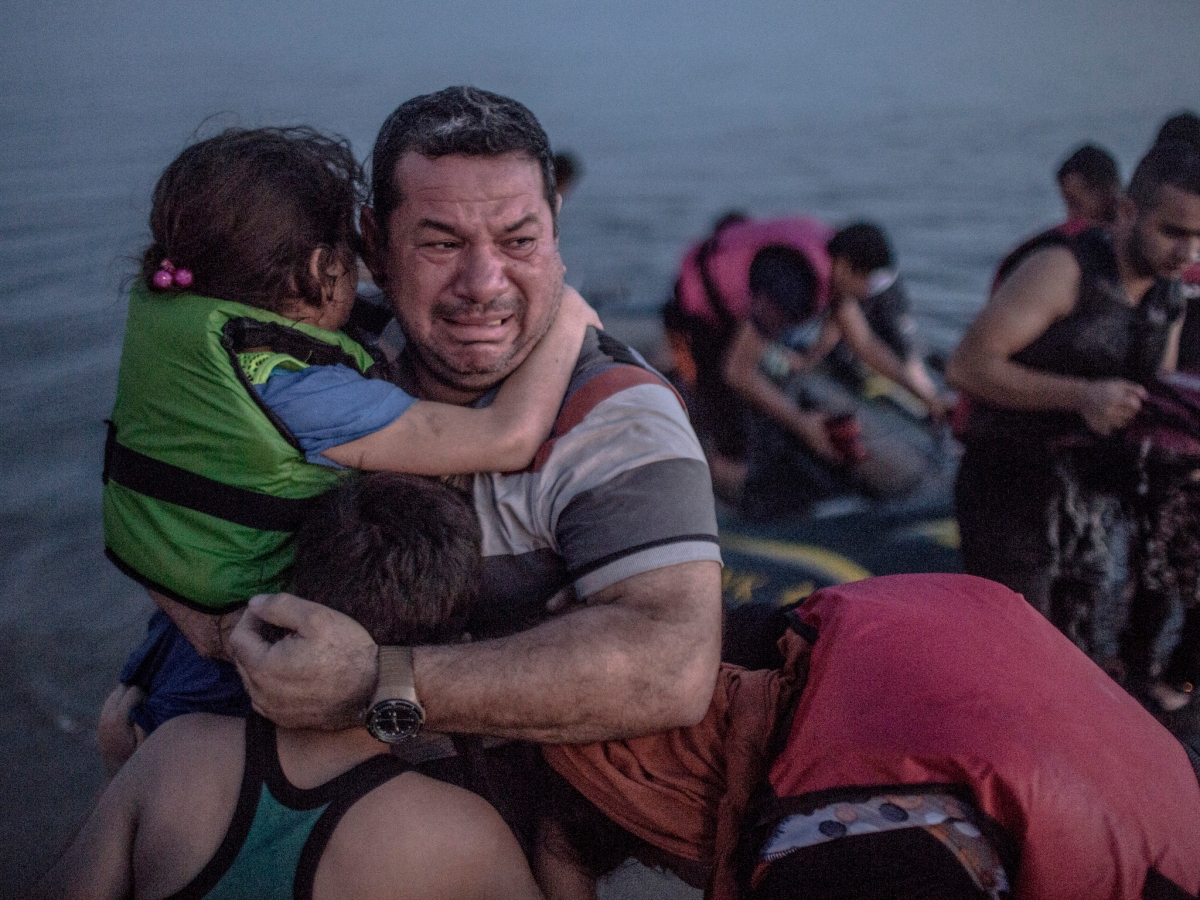
Refugee crisis: Father photographed crying with children in Kos has reached Germany | source:The Independent
By Lisbeth Coiman
Through the screen of my computer, I look into the eyes of a grown man crying while holding two young children, one still wearing a life safe jacket after surviving the perilous trip across the Aegean. For five years, refugees from war-torn Syria have found their way out of the horrors fallen upon the once thriving country by both a totalitarian regime and a terrorist organization. They run away from what’s too much to bear any longer.
Syrian refugees start in Aleppo, the last stop in the millennial silk route. Across an ISIS- controlled high way, they make it to Turkey, where at the Bodrum Peninsula, they board an inflatable boat to cross the 2.5 miles stretch to the island of Kos in Greece. They take nothing with them. It is estimated that 3.8 million Syrians have fled their country in the last five years escaping both civil war and terrorism. Most live in refugee camps in Jordan, Lebanon, or in European countries as far north as Denmark, Sweden and Norway. Some even make it across the Atlantic to the United States, where they are not welcome.
Inevitably while reading the news, I remember my own immigration trip from Venezuela to Canada, not as dangerous as a refugee journey, but I also left behind all I knew and held dear for the illusion of a better life somewhere else. Like the man in the picture, I once cried holding my two young children, after leaving behind my homeland.
The Pearson Airport in Toronto, Canada smelled of hope and uncertainty. We found a cart to put the suitcases, six in total, the maximum allowed. We had sold all our belongings, paid our small debts, and brought with us light clothes, baby things, and our savings, enough to soften the landing.
“Welcome to Canada,” an official looking man shook our hands with a reassuring smile, marking the significance of the moment for us, a move towards the illusion of a better life. He then directed us to the welcome lounge where a wall of pamphlets in every imaginable language displayed instructions on how to be a Canadian. We were welcomed, at least officially.
In the United States, Syrian refugees are not so lucky. In one of his first statements as a presidential candidate, the infamous Donald Trump said he would corral refugees from Syria and send them back to where they come from. My heart sunk when I heard those words on television. Additionally, HR 4038 passed in Nov. 2015 prevents refugees from Iraq and Syria from entering the US until new safety measures were in place.
Other countries in Europe have found strong opposition from right wings groups not ready to receive the innocent civilians traumatized by war and stigmatized by the image of terrorists in the name of Islam. Since the end of 2015, Europe has experienced a frenzy of overnight barriers built across its borders, putting an end to the free movement ideals that have reigned since the inception of the European Union.
Although we share narratives of displacement and survival, the Syrian refugees today face challenges that most immigrants will find impossible to overcome. In the heist of the escape, luggage is too heavy to carry on an inflatable lifeboat. The man crying in the picture had only a watch and two children with him. He was displaced, in the truest sense of the word, and his tears show the level of stress he was enduring at the time of the picture.
Mental illness caused by the stress of displacement has become a major concern among agencies offering support in the Syrian refugee crisis. According to Caritas Internationalis,“one in five Syrian refugees in Jordan need psychological therapy.” Children refugees are particularly at risk of developing a mental disorder, and constantly show symptoms of trauma and nightmares.
Before the end of our first year in Canada, my husband and I suffered the saddest episode of our lives. I had a mental breakdown. Images of my childhood in a rural community in Venezuela in the 60s kept popping up in the multicultural neighborhood I now lived in a suburb of Toronto. The country I left behind with it’s colorful and festive people, and its luscious, tropical landscape appeared to me unexpectedly around every corner even in the cruel northern winter, while my husband climbed the outdoor stairs of oil tanks in a nearby oil lube plant.
Then we were alone, and solitude is infinite without family and the support network left behind in the country of origin. I hallucinated, howling inside a walking closet, terrified by the painful memories of a childhood gone wrong, while my husband took a leave of absence and nursed me into recovery. “Please, don’t go so far beyond the line that I can’t reach you anymore,” he said. “Don’t leave me alone here, in this country.” I have since recovered.
Immigrants and refugees alike, we bring our past, our baggage, and our heritage, the unseen marks that determine the fabric that’ll help us survive the journey or not. Hope is the fuel that moves us all into a better life.
My journey as an immigrant in North America, it’s also a journey of recovery from child abuse and mental illness. My light luggage didn’t reflect what was inside my head, or the strength of my spirit. I recovered with the helped of a dear friend, and my husband. We move yet again to the United States where we built a beautiful life. I also helped my children grow into successful young men while I tagged along behind them, pushing, cheering, and encouraging them to reach high.
After all, the intent of this journey relies on the illusion of a better life, for them, or for me, it doesn’t matter. What matters is to escape what we can’t bear any longer.





